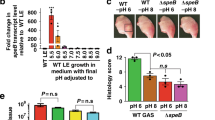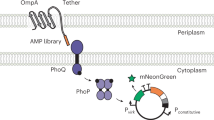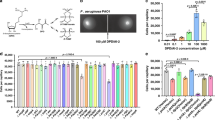Abstract
Free-living organisms have the ability to gauge their surroundings and modify their gene expression patterns in ways that help them cope with new environments. Here we discuss the physiological significance of recent reports describing the ability of the Salmonella typhimurium PhoP/PhoQ two-component system to recognize and respond to host-derived antimicrobial peptides.
This is a preview of subscription content, access via your institution
Access options
Subscribe to this journal
Receive 12 print issues and online access
$209.00 per year
only $17.42 per issue
Buy this article
- Purchase on Springer Link
- Instant access to full article PDF
Prices may be subject to local taxes which are calculated during checkout

Similar content being viewed by others
References
Dominguez-Bernal, G. et al. Repression of the RcsC-YojN-RcsB phosphorelay by the IgaA protein is a requisite for Salmonella virulence. Mol. Microbiol. 53, 1437–1449 (2004).
Garcia-Calderon, C. B., Garcia-Quintanilla, M., Casadesus, J. & Ramos-Morales, F. Virulence attenuation in Salmonella enterica rcsC mutants with constitutive activation of the Rcs system. Microbiology 151, 579–588 (2005).
Humphreys, S. et al. Role of the two-component regulator CpxAR in the virulence of Salmonella enterica serotype Typhimurium. Infect. Immun. 72, 4654–4661 (2004).
Mouslim, C., Delgado, M. & Groisman, E. A. Activation of the RcsC/YojN/RcsB phosphorelay system attenuates Salmonella virulence. Mol. Microbiol. 54, 386–395 (2004).
Lyon, G. J. & Novick, R. P. Peptide signaling in Staphylococcus aureus and other Gram-positive bacteria. Peptides 25, 1389–1403 (2004).
Johansson, J. et al. An RNA thermosensor controls expression of virulence genes in Listeria monocytogenes. Cell 110, 551–561 (2002).
Curtiss, R. 3rd & Kelly, S. M. Salmonella typhimurium deletion mutants lacking adenylate cyclase and cyclic AMP receptor protein are avirulent and immunogenic. Infect. Immun. 55, 3035–3043 (1987).
Saier, M. H., Ramseier, T. M. & Reizer, J. in Escherichia coli and Salmonella: Cellular and Molecular Biology (eds Niedhardt, F. C. et al.) 1325–1343 (ASM Press, Washington DC, 1996).
Krukonis, E. S. & DiRita, V. J. From motility to virulence: sensing and responding to environmental signals in Vibrio cholerae. Curr. Opin. Microbiol. 6, 186–190 (2003).
Welch, T. J. & Bartlett, D. H. Identification of a regulatory protein required for pressure-responsive gene expression in the deep-sea bacterium Photobacterium species strain SS9. Mol. Microbiol. 27, 977–985 (1998).
Bader, M. W. et al. Regulation of Salmonella typhimurium virulence gene expression by cationic antimicrobial peptides. Mol. Microbiol. 50, 219–230 (2003).
Bader, M. W. et al. Recognition of antimicrobial peptides by a bacterial sensor kinase. Cell 122, 461–472 (2005).
Vaara, M. Agents that increase the permeability of the outer membrane. Microbiol. Rev. 56, 395–411 (1992).
Cho, U. S. et al. Metal bridges between the PhoQ sensor domain and the membrane regulate transmembrane signaling. J. Mol. Biol. 356, 1193–1206 (2006).
Castelli, M. E., Cauerhff, A., Amongero, M., Soncini, F. C. & Vescovi, E. G. The H box-harboring domain is key to the function of the Salmonella enterica PhoQ Mg2+-sensor in the recognition of its partner PhoP. J. Biol. Chem. 278, 23579–23585 (2003).
Montagne, M., Martel, A. & Le Moual, H. Characterization of the catalytic activities of the PhoQ histidine protein kinase of Salmonella enterica serovar Typhimurium. J. Bacteriol. 183, 1787–1791 (2001).
Chamnongpol, S., Cromie, M. & Groisman, E. A. Mg2+ sensing by the Mg2+ sensor PhoQ of Salmonella enterica. J. Mol. Biol. 325, 795–807 (2003).
Lee, Y. W., Jin, S., Sim, W. S. & Nester, E. W. Genetic evidence for direct sensing of phenolic compounds by the VirA protein of Agrobacterium tumefaciens. Proc. Natl Acad. Sci. USA 92, 12245–12249 (1995).
Ernst, R. K., Guina, T. & Miller, S. I. Salmonella typhimurium outer membrane remodeling: role in resistance to host innate immunity. Microbes Infect. 3, 1327–1334 (2001).
Guina, T., Yi, E. C., Wang, H., Hackett, M. & Miller, S. I. A PhoP-regulated outer membrane protease of Salmonella enterica serovar Typhimurium promotes resistance to α-helical antimicrobial peptides. J. Bacteriol. 182, 4077–4086 (2000).
Fields, P. I., Swanson, R. V., Haidaris, C. G. & Heffron, F. Mutants of Salmonella typhimurium that cannot survive within the macrophage are avirulent. Proc. Natl Acad. Sci. USA 83, 5189–5193 (1986).
Rosenberger, C. M., Gallo, R. L. & Finlay, B. B. Interplay between antibacterial effectors: a macrophage antimicrobial peptide impairs intracellular Salmonella replication. Proc. Natl Acad. Sci. USA 101, 2422–2427 (2004).
Akira, S., Uematsu, S. & Takeuchi, O. Pathogen recognition and innate immunity. Cell 124, 783–801 (2006).
Zwir, I. et al. Dissecting the PhoP regulatory network of Escherichia coli and Salmonella enterica. Proc. Natl Acad. Sci. USA 102, 2862–2867 (2005).
Groisman, E. A. The pleiotropic two-component regulatory system PhoP–PhoQ. J. Bacteriol. 183, 1835–1842 (2001).
Soncini, F. C. & Groisman, E. A. Two-component regulatory systems can interact to process multiple environmental signals. J. Bacteriol. 178, 6796–6801 (1996).
Alpuche Aranda, C. M., Swanson, J. A., Loomis, W. P. & Miller, S. I. Salmonella typhimurium activates virulence gene transcription within acidified macrophage phagosomes. Proc. Natl Acad. Sci. USA 89, 10079–10083 (1992).
Garcia Vescovi, E., Soncini, F. C. & Groisman, E. A. Mg2+ as an extracellular signal: environmental regulation of Salmonella virulence. Cell 84, 165–174 (1996).
Kox, L. F., Wosten, M. M. & Groisman, E. A. A small protein that mediates the activation of a two-component system by another two-component system. EMBO J. 19, 1861–1872 (2000).
Brodsky, I. E., Ernst, R. K., Miller, S. I. & Falkow, S. mig-14 is a Salmonella gene that plays a role in bacterial resistance to antimicrobial peptides. J. Bacteriol. 184, 3203–3213 (2002).
Tierrez, A. & Garcia- del Portillo, F. The Salmonella membrane protein IgaA modulates the activity of the RcsC-YojN-RcsB and PhoP-PhoQ regulons. J. Bacteriol. 186, 7481–7489 (2004).
Mouslim, C., Latifi, T. & Groisman, E. A. Signal-dependent requirement for the co-activator protein RcsA in transcription of the RcsB-regulated ugd gene. J. Biol. Chem. 278, 50588–50595 (2003).
Zasloff, M. Antimicrobial peptides of multicellular organisms. Nature 415, 389–395 (2002).
Hancock, R. E. & Diamond, G. The role of cationic antimicrobial peptides in innate host defences. Trends Microbiol. 8, 402–410 (2000).
Brogden, K. A. Antimicrobial peptides: pore formers or metabolic inhibitors in bacteria? Nature Rev. Microbiol. 3, 238–250 (2005).
Wade, D. et al. All-D amino acid-containing channel-forming antibiotic peptides. Proc. Natl Acad. Sci. USA 87, 4761–4765 (1990).
Nikaido, H. Molecular basis of bacterial outer membrane permeability revisited. Microbiol. Mol. Biol. Rev. 67, 593–656 (2003).
Majdalani, N., Chen, S., Murrow, J., St John, K. & Gottesman, S. Regulation of RpoS by a novel small RNA: the characterization of RprA. Mol. Microbiol. 39, 1382–1394 (2001).
Peterson, C. N., Carabetta, V. J., Chowdhury, T. & Silhavy, T. J. LrhA regulates rpoS translation in response to the Rcs phosphorelay system in Escherichia coli. J. Bacteriol. 188, 3175–3181 (2006).
Sailer, F. C., Meberg, B. M. & Young, K. D. β-Lactam induction of colanic acid gene expression in Escherichia coli. FEMS Microbiol. Lett. 226, 245–249 (2003).
Majdalani, N. & Gottesman, S. The Rcs phosphorelay: a complex signal transduction system. Annu. Rev. Microbiol. 59, 379–405 (2005).
Detweiler, C. S., Monack, D. M., Brodsky, I. E., Mathew, H. & Falkow, S. virK, somA and rcsC are important for systemic Salmonella enterica serovar Typhimurium infection and cationic peptide resistance. Mol. Microbiol. 48, 385–400 (2003).
Groisman, E. A., Chiao, E., Lipps, C. J. & Heffron, F. Salmonella typhimurium phoP virulence gene is a transcriptional regulator. Proc. Natl Acad. Sci. USA 86, 7077–7081 (1989).
Groisman, E. A., Heffron, F. & Solomon, F. Molecular genetic analysis of the Escherichia coli phoP locus. J. Bacteriol. 174, 486–491 (1992).
Lesley, J. A. & Waldburger, C. D. Comparison of the Pseudomonas aeruginosa and Escherichia coli PhoQ sensor domains: evidence for distinct mechanisms of signal detection. J. Biol. Chem. 276, 30827–30833 (2001).
Chamnongpol, S. & Groisman, E. A. Mg2+ homeostasis and avoidance of metal toxicity. Mol. Microbiol. 44, 561–571 (2002).
Minagawa, S. et al. Isolation and molecular characterization of the locked-on mutant of Mg2+ sensor PhoQ in Escherichia coli. Biosci. Biotechnol. Biochem. 69, 1281–1287 (2005).
Minagawa, S. et al. Identification and molecular characterization of the Mg2+ stimulon of Escherichia coli. J. Bacteriol. 185, 3696–3702 (2003).
Zhou, D. et al. Transcriptome analysis of the Mg2+-responsive PhoP regulator in Yersinia pestis. FEMS Microbiol. Lett. 250, 85–95 (2005).
Winfield, M. D., Latifi, T. & Groisman, E. A. Transcriptional regulation of the 4-amino-4-deoxy-L-arabinose biosynthetic genes in Yersinia pestis. J. Biol. Chem. 280, 14765–14772 (2005).
Moss, J. E., Fisher, P. E., Vick, B., Groisman, E. A. & Zychlinsky, A. The regulatory protein PhoP controls susceptibility to the host inflammatory response in Shigella flexneri. Cell. Microbiol. 2, 443–452 (2000).
Llama-Palacios, A., Lopez-Solanilla, E., Poza-Carrion, C., Garcia-Olmedo, F. & Rodriguez-Palenzuela, P. The Erwinia chrysanthemi phoP-phoQ operon plays an important role in growth at low pH, virulence and bacterial survival in plant tissue. Mol. Microbiol. 49, 347–357 (2003).
Derzelle, S. et al. The PhoP-PhoQ two-component regulatory system of Photorhabdus luminescens is essential for virulence in insects. J. Bacteriol. 186, 1270–1279 (2004).
McPhee, J. B., Lewenza, S. & Hancock, R. E. Cationic antimicrobial peptides activate a two-component regulatory system, PmrA-PmrB, that regulates resistance to polymyxin B and cationic antimicrobial peptides in Pseudomonas aeruginosa. Mol. Microbiol. 50, 205–217 (2003).
Ernst, R. K. et al. Specific lipopolysaccharide found in cystic fibrosis airway Pseudomonas aeruginosa. Science 286, 1561–1565 (1999).
Soncini, F. C., Garcia Vescovi, E., Solomon, F. & Groisman, E. A. Molecular basis of the magnesium deprivation response in Salmonella typhimurium: identification of PhoP-regulated genes. J. Bacteriol. 178, 5092–5099 (1996).
Groisman, E. A., Kayser, J. & Soncini, F. C. Regulation of polymyxin resistance and adaptation to low-Mg2+ environments. J. Bacteriol. 179, 7040–7045 (1997).
Guo, L. et al. Lipid A acylation and bacterial resistance against vertebrate antimicrobial peptides. Cell 95, 189–198 (1998).
Shi, Y., Latifi, T., Cromie, M. J. & Groisman, E. A. Transcriptional control of the antimicrobial peptide resistance ugtL gene by the Salmonella PhoP and SlyA regulatory proteins. J. Biol. Chem. 279, 38618–38625 (2004).
Belden, W. J. & Miller, S. I. Further characterization of the PhoP regulon: identification of new PhoP-activated virulence loci. Infect. Immun. 62, 5095–5101 (1994).
Bijlsma, J. J. & Groisman, E. A. The PhoP/PhoQ system controls the intramacrophage type three secretion system of Salmonella enterica. Mol. Microbiol. 57, 85–96 (2005).
Norte, V. A., Stapleton, M. R. & Green, J. PhoP-responsive expression of the Salmonella enterica serovar Typhimurium slyA gene. J. Bacteriol. 185, 3508–3514 (2003).
Shi, Y., Cromie, M. J., Hsu, F. F., Turk, J. & Groisman, E. A. PhoP-regulated Salmonella resistance to the antimicrobial peptides magainin 2 and polymyxin B. Mol. Microbiol, 53, 229–241 (2004).
Bajaj, V., Lucas, R. L., Hwang, C. & Lee, C. A. Co-ordinate regulation of Salmonella typhimurium invasion genes by environmental and regulatory factors is mediated by control of hilA expression. Mol. Microbiol. 22, 703–714 (1996).
Fields, P. I., Groisman, E. A. & Heffron, F. A Salmonella locus that controls resistance to microbicidal proteins from phagocytic cells. Science 243, 1059–1062 (1989).
Behlau, I. & Miller, S. I. A PhoP-repressed gene promotes Salmonella typhimurium invasion of epithelial cells. J. Bacteriol. 175, 4475–4484 (1993).
Brodsky, I. E., Ghori, N., Falkow, S. & Monack, D. Mig-14 is an inner membrane-associated protein that promotes Salmonella typhimurium resistance to CRAMP, survival within activated macrophages and persistent infection. Mol. Microbiol. 55, 954–972 (2005).
Uchiya, K. et al. A Salmonella virulence protein that inhibits cellular trafficking. EMBO J. 18, 3924–3933 (1999).
Blanc-Potard, A. B. & Groisman, E. A. The Salmonella selC locus contains a pathogenicity island mediating intramacrophage survival. EMBO J. 16, 5376–5385 (1997).
Groisman, E. A. The ins and outs of virulence gene expression: Mg2+ as a regulatory signal. Bioessays 20, 96–101 (1998).
Steele-Mortimer, O., St-Louis, M., Olivier, M. & Finlay, B. B. Vacuole acidification is not required for survival of Salmonella enterica serovar Typhimurium within cultured macrophages and epithelial cells. Infect. Immun. 68, 5401–5404 (2000).
Garvis, S. G., Beuzon, C. R. & Holden, D. W. A role for the PhoP/Q regulon in inhibition of fusion between lysosomes and Salmonella-containing vacuoles in macrophages. Cell. Microbiol. 3, 731–744 (2001).
Lee, C. A., Jones, B. D. & Falkow, S. Identification of a Salmonella typhimurium invasion locus by selection for hyperinvasive mutants. Proc. Natl Acad. Sci. USA 89, 1847–1851 (1992).
Galan, J. E. & Curtiss, R. 3rd. Cloning and molecular characterization of genes whose products allow Salmonella typhimurium to penetrate tissue culture cells. Proc. Natl Acad. Sci. USA 86, 6383–6387 (1989).
Salzman, N. H. et al. Enteric Salmonella infection inhibits Paneth cell antimicrobial peptide expression. Infect. Immun. 71, 1109–1115 (2003).
Vazquez-Torres, A. et al. Extraintestinal dissemination of Salmonella by CD18-expressing phagocytes. Nature 401, 804–808 (1999).
Martin-Orozco, N. et al. Visualization of vacuolar acidification-induced transcription of genes of pathogens inside macrophages. Mol. Biol. Cell 17, 498–510 (2006).
Garcia-del Portillo, F., Foster, J. W., Maguire, M. E. & Finlay, B. B. Characterization of the micro-environment of Salmonella typhimurium-containing vacuoles within MDCK epithelial cells. Mol. Microbiol. 6, 3289–3297 (1992).
Lee, A. K., Detweiler, C. S. & Falkow, S. OmpR regulates the two-component system SsrA-SsrB in Salmonella pathogenicity island 2. J. Bacteriol. 182, 771–781 (2000).
Buchmeier, N. et al. A parallel intraphagosomal survival strategy shared by Mycobacterium tuberculosis and Salmonella enterica. Mol. Microbiol. 35, 1375–1382 (2000).
Lavigne, J. P., O'Callaghan, D. & Blanc-Potard, A. B. Requirement of MgtC for Brucella suis intramacrophage growth: a potential mechanism shared by Salmonella enterica and Mycobacterium tuberculosis for adaptation to a low-Mg2+ environment. Infect. Immun. 73, 3160–3163 (2005).
Wu, L. et al. Recognition of host immune activation by Pseudomonas aeruginosa. Science 309, 774–777 (2005).
Rediers, H., Vanderleyden, J. & De Mot, R. Azotobacter vinelandii: a Pseudomonas in disguise? Microbiology 150, 1117–1119 (2004).
Winfield, M. D. & Groisman, E. A. Role of nonhost environments in the lifestyles of Salmonella and Escherichia coli. Appl. Environ. Microbiol. 69, 3687–3694 (2003).
Acknowledgements
We thank members of our laboratory for discussions. Our research on the PhoP/PhoQ system is funded in part by the National Institutes of Health. E.A.G. is an investigator of the Howard Hughes Medical Institute.
Author information
Authors and Affiliations
Corresponding author
Ethics declarations
Competing interests
The authors declare no competing financial interests.
Related links
Related links
DATABASES
Entrez Genome Project
FURTHER INFORMATION
Rights and permissions
About this article
Cite this article
Groisman, E., Mouslim, C. Sensing by bacterial regulatory systems in host and non-host environments. Nat Rev Microbiol 4, 705–709 (2006). https://doi.org/10.1038/nrmicro1478
Published:
Issue Date:
DOI: https://doi.org/10.1038/nrmicro1478
This article is cited by
-
An E. coli display method for characterization of peptide–sensor kinase interactions
Nature Chemical Biology (2023)
-
Nitric oxide is a host cue for Salmonella Typhimurium systemic infection in mice
Communications Biology (2023)
-
A novel STK1-targeted small-molecule as an “antibiotic resistance breaker” against multidrug-resistant Staphylococcus aureus
Scientific Reports (2017)
-
Urocanate as a potential signaling molecule for bacterial recognition of eukaryotic hosts
Cellular and Molecular Life Sciences (2014)
-
A Mutation in tdcA Attenuates the Virulence of Salmonella enterica Serovar Typhimurium
Molecules and Cells (2010)



